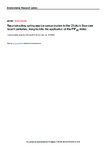Reconstructing spring sea ice concentration in the Chukchi Sea over recent centuries: insights into the application of the PIP25 index

Date
2019-11-27Author
Subject
Metadata
Show full item recordAbstract
<jats:title>Abstract</jats:title> <jats:p>In this study, we aimed to reconstruct spring (April–June) sea ice changes in the western Arctic Ocean over recent centuries (ca. the last 250 years) by measuring biomarker distributions in a multicore (ARA01B-03MUC) retrieved from the Chukchi Shelf region and to evaluate outcomes against known or modelled estimates of sea ice conditions. Specifically, we analyzed for the Arctic sea ice proxy IP<jats:sub>25</jats:sub> and assessed the suitability of a further highly branched isoprenoid (HBI) lipid (HBI III), epi-brassicasterol, and dinosterol as complementary biomarkers for use with the so-called phytoplankton marker-IP<jats:sub>25</jats:sub> index (PIP<jats:sub>25</jats:sub>; P<jats:sub>III</jats:sub>IP<jats:sub>25</jats:sub>, P<jats:sub>B</jats:sub>IP<jats:sub>25</jats:sub>, and P<jats:sub>D</jats:sub>IP<jats:sub>25</jats:sub>, respectively). The presence of IP<jats:sub>25</jats:sub> throughout core ARA01B-03MUC confirms the occurrence of seasonal sea ice at the study site over recent centuries. From a semi-quantitative perspective, all three PIP<jats:sub>25</jats:sub> indices gave different trends, with some dependence on the balance factor <jats:italic>c</jats:italic>, a term used in the calculation of the PIP<jats:sub>25</jats:sub> index. P<jats:sub>III</jats:sub>IP<jats:sub>25</jats:sub>-derived spring sea ice concentration (SpSIC) estimates using a <jats:italic>c</jats:italic> value of 0.63, determined previously from analysis of Barents Sea surface sediments, were likely most reliable, since SpSIC values were high throughout the record (SpSIC > 78%), consistent with the modern context for the Chukchi Sea and the mean SpSIC record of the 41 CMIP5 climate models over recent centuries. P<jats:sub>B</jats:sub>IP<jats:sub>25</jats:sub>-based SpSIC estimates were also high (SpSIC 108%−127%), albeit somewhat over-estimated, when using a <jats:italic>c</jats:italic> value of 0.023 obtained from a pan-Arctic distribution of surface sediments. In contrast, P<jats:sub>D</jats:sub>IP<jats:sub>25</jats:sub> values using a pan-Arctic <jats:italic>c</jats:italic> value of 0.11, and PIP<jats:sub>25</jats:sub> data based on the mean biomarker concentrations from ARA01B-03MUC, largely underestimated sea ice conditions (SpSIC as low as 13%), and exhibited poor agreement with instrumental records or model outputs. On the other hand, P<jats:sub>B</jats:sub>IP<jats:sub>25</jats:sub> values using a <jats:italic>c</jats:italic> factor based on mean IP<jats:sub>25</jats:sub> and epi-brassicasterol concentrations exhibited a decline towards the core top, which resembled recent decreasing changes in summer sea ice conditions for the Chukchi Sea; however, further work is needed to test the broader spatial generality of this observation.</jats:p>
Publisher
Journal
Volume
Issue
Pagination
Number
Recommended, similar items
The following license files are associated with this item:

